#Rita Hayworth - The Heat is On
Text

Quinn Lemley
Through Rita Hayworth - The Heat is On, Singer/Performer Transforms Into the Legendary Star
by Brad Balfour
On Nov 20, 2023, the singer/style queen Quinn Lemley will present her last NYC performance of The Heat Is On! – Rita Hayworth at Don’t Tell Mama (343 W 46th St.), the long-established cabaret center in midtown Manhattan, before going on the road. Hayworth, known as “The Love Goddess,” is iconic for her indelible performance in Gilda, the film noir classic – performing the sexiest striptease on celluloid, “Put The Blame On Mame.” The hottest sex symbol of the 1940s, Hayworth’s pin-up on the Atomic Bomb gave her the international title of “The Atomic Star.” Courted by the world’s most powerful men – Orson Welles, Prince Aly Khan, and Howard Hughes among others – Hayworth was a legend until she had early onset Alzheimer’s Disease which led to her death.
Fire-haired performer Lemley brings the star to life in her sold-out shows. Having headlined various performing arts centers and casinos across North America, she received The Bistro Award and two MAC award nominations. Lemley’s jazz quintet performs internationally and she’s the iconic face of the Half Note in Athens, Greece. The New York Times defines her performances as "Dazzling... with one show-stopping number after another!"
Besides this show, Lemley has directed and co-produced Rebel Rebel, The Many Lives of David Bowie, Pink Floyd’s Dark Side of the Wall and The Ultimate Queen Celebration. She’s had a presence on national TV through appearances on Good Morning America, Oprah and as a finalist on Shark Tank. Lemley also has five CDs available, and her music is on Spotify and Apple Music. She’s hosting the locally produced TV show, Secrets of the Stage on MNN.org with a monthly virtual concert on Zoom -- “Up Close & Personal.” A graduate of NYU Tisch School of the Arts, she's a Distinguished Toastmaster at Toastmasters International and a member of National Speakers Association as well as SAG, AFTRA, AEA, DTM, NSA NY, APAP, and IEBA.
This critically acclaimed concert about Hayworth's life — the star who built Columbia Pictures — is a humorous, heartfelt and heartbreaking look at The Golden Age of Hollywood, the MeToo movement and the price of fame — especially in light of Hayworth's tumultuous relationship with the head of Columbia, the infamous Harry Cohn. The show reflects the price of fame, celebrating a remarkable life with humor, wit and impeccable storytelling. It’s all woven together with tunes from The Great American Songbook and the Golden Age of Hollywood.
Written and directed by Carter Inskeep (“Always Patsy Cline”), Lemley’s performance is either backed by a quartet or by an 11-piece big band. The show includes hits from such legendary composers and lyricists as Irving Berlin, Harold Arlen and Jerome Kern. It includes “Bewitched,” “Zip,” and “The Lady is A Tramp” from such iconic films as “Gilda,” “Pal Joey,” “Cover Girl” and more.
The following Q&A was conducted online in advance of the upcoming show.
When did you know you wanted to be a performer?
I came out of the womb entertaining. I’ve always known that I wanted to perform. Singing and acting have always been my passion. Even as a young girl from Indiana I was always producing puppet shows, carnivals and musicals for our neighborhood. Luckily, my parents were incredibly supportive and made sure I took lessons and classes. I’m so grateful today!
Talk about the first time you performed. Can you describe the moment?
My first show was when I was in fifth grade. I played a Far-Out Foxy Lady from A Foreign Land in Whitecloud and the Seven Dwarfs. I guess I was bound to be a glamour gal from the get-go!
Have you focused on cabaret because of the intimacy of the experience?
I love cabaret. I love its intimacy. It’s taught me to connect to each and every person in the room. It provides an opportunity to try things out and to take a chance, to take risks.
Although it’s been a big part of my life, I haven’t focused on cabaret. My late husband -– producer, manager and best friend, Paul Horton -- expanded my shows by putting them with 9- to 12-piece big bands. That opened up the scope of our shows. For the past 15 years, I’ve been headlining casinos and performing arts centers like The Kravis Center, Naples Philharmonic, Thousand Oaks Civic Center and BB Kings in NYC. After Covid, Paul suggested I go back to the club where I started my career -- Don’t Tell Mama in NYC -- before going back on the road in theaters. We won the Bistro Award, a MAC Nomination, rave reviews and have enjoyed a 17-month residency. I’m grateful Paul booked these dates leading up to going back to theaters starting in North Carolina at the Tryon Center Nov. 4, The Pheasantry in London on Feb 16 & 17th, and a one-week run at The Cape May Playhouse in July. We have our last NYC date on Monday, Nov. 20 at Don’t Tell Mama. It’s given me a chance to heal and put myself into the performance on another level.
How do you choose the songs you do?
First, it’s the lyrics. What am I trying to say? How do I want to say it? Where does it fit into the show? Secondly, it’s about melody and structure. How does the melody make me and the audience feel? How do I want it arranged to tell the story? Finally, does it fit me as an artist? I love all kinds of music. But like clothing, not everything fits with my voice and personality or belongs in the arc of the story that I’m telling. I have to try the songs out and see how they feel and sound in my voice.
How did you develop this show?
Rita Hayworth – The Heat Is On! has had three stages of development. The first stage was when I got out of NYU. I was starring in a show off Broadway. A reviewer saw me and said, “You look like Rita Hayworth. You should meet Carter Inskeep and do the story of her life.” That was pre-internet, so we read every biography, watched her films on tape and went to the library. We also read every article we could find on microfiche. The question we kept asking was, “Who is Rita Hayworth – the public persona? But more importantly, who is Margarita Cansino? The girl who has hopes and dreams and just wants to be loved?” Just like me, like all of us. We had tremendous success, got rave reviews, were on Oprah, Geraldo, Good Morning America. I was in my mid 20s then. In my 30s, I met Paul Horton. He changed my life. He had us rewrite the show, using the songs from the Great American Songbook during the Golden Age of Hollywood to help tell the story instead of limiting it to songs from Rita’s films. He had it orchestrated for both a big band and a quartet. Now we can play intimate theaters as well as large ones like The Kravis Center, Naples Philharmonic and BB King’s. We toured throughout North America. During Covid, Carter rewrote the book to make the story about resilience, accepting our choices with topics like the “Me Too” movement, women’s empowerment and the price of fame. He had us return to Don't Tell Mama’s in NYC where we started the show after COVID, before going back on tour in theaters. Our residency was so successful that we got extended from four to 17 months, had rave reviews, won the Bistro Award and got a MAC Nomination.
Besides this one performance left in NYC on Monday, Nov. 20, I’m going to London in February at The Pheasantry. I am so grateful that Paul put this in motion. It's been a lifesaver since he unexpectedly passed in March. It was his vision to do this residency. The story is so rich, deep, funny and moving. I’ve been able to tap into Rita’s story on a deeper level than I ever could have when I was younger. I’ve been able to put myself into the role in a way I never dreamed was possible. And the audiences are responding.
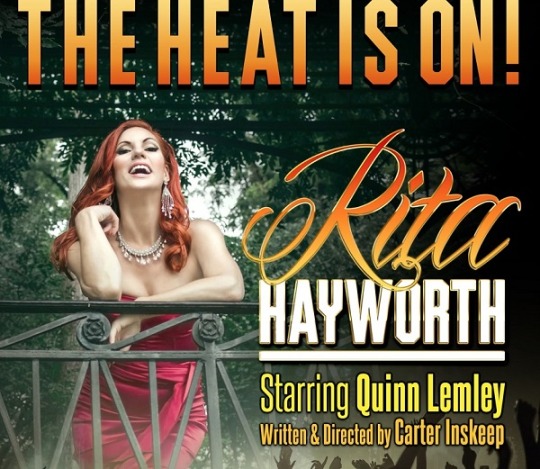
Do you try to make your shows thematic, or sometimes just a simple revue?
All of my shows are thematic. The Heat is On – Rita Hayworth is about Rita and The Golden Age of Hollywood. Burlesque to Broadway is about the women who went from Burlesque to Broadway and Beyond. As a director and producer, I've done these shows: The Ultimate Queen Celebration, Rebel Rebel: The Many Lives of David Bowie and Pink Floyd’s Dark Side of the Wall. My TV Talk show on MNN, Secrets of the Stage is where I pull back the curtains and explore the creative process. My speaking keynote is about resilience through the lens of my relationship with my shows Rita and Burlesque to Broadway.
You did have a burlesque moment. Did it feel liberating, powerful or what?
I did a show called Burlesque To Broadway. It was so liberating. I was onstage with four beautiful and talented women who celebrated their talent, beauty and humor. It was powerful to claim and own my femininity and fun to tease. As the great poet Mel Brooks said, “When You Got It, Flaunt It.” Every woman should step into her power and “Be”!
Besides the songs you're already playing, what are your benchmark tunes?
My heroine is Julia Child. I got to have lunch with her at her house in Cambridge with her husband Paul. Her spirit was incredible. She was a woman who took massive action and didn’t let anyone or anything stop her. Other icons of mine are Cher, Ann-Margret, Lady GaGa and Diana Ross. I’m putting a list of songs from '70s and '80s rock, so my benchmark songs are "The Show Must Go On," "You Take My Breath Away" and "Rock and Roll Suicide." I perform Queen and Bowie plus others to celebrate my late husband, Paul’s genius and talent. Plus, “Don’t Fret World” from his Rock Opera which was his anthem.
Who would you like to perform with or what show would like to be in?
My dream is to work with the French artist, arranger and producer Benjamin Biolay. And, of course, I’d love to work with David Foster.
What goals do you have for this show and for yourself?
We are going back on the road in theaters. I’m on a plane now headed to Tryon Arts Center in North Carolina. Going to London. I’m hoping to find producers and promoters who will help us tour and produce a run on the West End of London. I’d like to do a national tour. We’d also like to do a NetFlix special filming of the show for broadcast. Paul was my agent as well as producer, so I need to find an agent that can help me internationally. I am also looking to get my TV show, Secrets of the Stage, picked up by a major network with sponsorship. As a director and producer, I’m working on our tour of The Ultimate Queen Celebration with Yvan Pedneault and MiG Ayessa, both endorsed by Queen. It’s the best Queen tribute band on the market. We will be at The Egg in Albany, May 11th, and are routing around that. The audiences are on their feet. It's a Queen party.
Starting next month, I’m working on a new show with ’70s and ‘80s rock that’s a tribute to Paul and our incredible 20-year journey together through music. I’m grateful to have so many talented colleagues with me on my journey.
Who: Quinn Lemley
What: "Rita Hayworth - The Heat is On!"
When: November 20th, 2023
Where: Don’t Tell Mama – 343 W 46th St. – New York, NY – (212)-757-0788
For more info go to: www.QuinnLemley.com
Copyright ©2023 PopEntertainment.com. All rights reserved. Posted: November 15, 2023.
Photos ©2023. Courtesy of Quinn Lemley. All rights reserved.
youtube
2 notes
·
View notes
Text



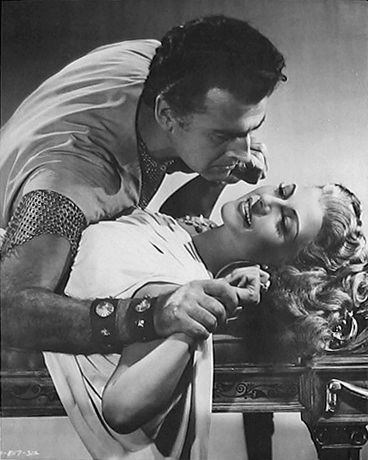
“About the love scene, the morning we were to film the most tempestuous one, Rita had clipped some pictures of herself and Glenn Ford in some passionate embraces from her other films and pasted them all over the mirror of my dressing room. She’d written a note: 'This is the way it’s to be done.’
Naturally, I couldn’t let something like that go unanswered. I realized the same chap who had staged Mickey Rooney’s musical numbers for a film was now doing Rita’s. So I got the still department to get me some pictures of Rooney. I selected the most grotesque, where he was pictured in the very heat of rehearsing the dance. I clipped those, pasted them to Rita’s dressing room mirror, and wrote the same words she had in my note.”
-Stewart Granger on making Salome with Rita Hayworth, Screenland, Dec. 1952
42 notes
·
View notes
Text
THIS DAY IN GAY HISTORY
based on: The White Crane Institute's 'Gay Wisdom', Gay Birthdays, Gay For Today, Famous GLBT, glbt-Gay Encylopedia, Today in Gay History, Wikipedia, and more … April 27



1906 – Friedrich-Paul von Groszheim (d.circa 2003), born in Lübeck, Germany was an ordinary German man who was imprisoned by the Nazis for the (then) crime of homosexuality under Germany's now-repealed Paragraph 175.
Von Groszheim was one of 230 men arrested in Lübeck on suspicion of being gay by the SS in January 1937 under paragraph 175, which outlawed homosexuality. He was imprisoned for ten months, during which he had to wear a badge emblazoned with a capital A, for Arschficker (arse-fucker):
They beat us to a pulp. I couldn't lie down...my whole back (was) bloody. You were beaten until you finally named names.
Von Groszheim was held in a cell with no heating, very little food, and no toilet facilities. Freed, he was rearrested in 1938 and tortured. Von Groszheim was eventually offered the 'alternative' of castration or Sachsenhausen concentration camp. He 'chose' castration. Terrible as it may seem, it was a decision that probably saved his life. He was then released.
Because of the castration, von Groszheim was rejected as physically unfit for military service in 1940. In 1943 he was arrested a third time, this time as a supporter of the former Kaiser Wilhelm II, and imprisoned as a political prisoner at Neuengamme concentration camp.
After the war, he settled in Hamburg.
Von Groszheim was never acknowledged as a victim of the Nazi regime, and due to on-going persecution of homosexuals in Germany, it took nearly half a century before he broke his silence. Eventually he explained why he began to speak out: 'I'm living proof that Hitler didn't win. I'm aware of that every day. If I don't tell my story, who will know the truth?.' He only told his story in 1992, on We Were Marked with a Big "A", a film in German with English subtitles.
In 1995, he was one of eight signers to a declaration given to the US Holocaust Memorial Museum in Washington, D.C. that called for the "memorializing and documenting of Nazi atrocities against homosexuals and others."

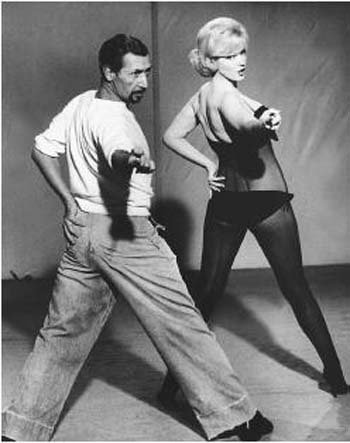
Jack Cole rehearsing Marilyn Monroe
1911 – Jack Cole (d.1974) was an American dancer, choreographer, and theatre director known as the father of theatrical jazz dance. He developed an entirely personal mode of jazz-ethnic-ballet that prevails as the dominant look of and technique for dancing in today's musicals, films, nightclub revues, television commercials and music videos.
Jack Cole, a student of Ravi Shankar's older brother Uday (who popularized East Indian dance in the West), danced with the staid orientalist Denishawn troupe, and invented jazz dance by applying what he knew of Indian dance to jazz music.
He stripped in Broadway's Ziegfield Follies Of 1943, opened New York's Rainbow Room, and formed a troupe that eroticized the Radio City Music Hall, Roxy, Ciro's, and the Fairmont and Dunes hotels.
His Hollywood entrance didn't go well: his specialty number for Fox's Moon Over Miami (1941) was cut as too sexy and he was fired by Arthur Freed from MGM's Ziegfield Follies (1946), for "griping about all the 'queen bees' like Cedric Gibbons and Roger Edens." Minnelli, Gibbons, et al, worked within the MGM closet, but Cole was a rebel and didn't hide his gayness.
At Columbia, then a minor studio, he lasted from 1944 until the McCarthy hearings of 1948, when most of his dancers fled to Europe. His first Columbia film was Cover Girl (1944) with Rita Hayworth, working with Gene Kelly, Stanley Donen, and Felix. He worked with Ann Miller and thrice more with Hayworth, his eroticism transferred almost intact to her in the 'Put the Blame on Mame' number in Gilda (1946), his homoeroticism most pronounced in the satirical 'Greek Ballet' in Down To Earth (1947). When Gilda describing herself stops in midsentence, the next word could be "stripper," for Cole based her movements on striptease.
At Fox, Cole vitalized Gwen Verdon in On The Riviera, revitalized Betty Grable in Meet Me After The Show (both 1951), surrounded Mitzi Gaynor with slinky catmen in The I Don't Care Girl (1953) and became Marilyn Monroe's dance guru from Gentlemen Prefer Blondes (1953) until the end of her life, surrounding her with musclemen in There's No Business Like Show Business (1954).
He returned to Metro for Vincente Minnelli's Kismet (1955; he had done the Broadway show and the 1944 film); Designing Woman; and, with Gene Kelly, Les Girls (1957).
Back at Columbia, he gave Betty Grable a male harem in Three For The Show (1955). His gayness was hidden within his Orientalism, suggesting to Shirley McLean that "masculinity and gay identity" are not necessarily antithetical, erasing gender (unlike true oriental dance), and sought after by female dancers.
But "for gay audiences, the classic Cole number" is 'Is There Anyone Here For Love?' in Gentlemen Prefer Blondes, featuring Physique Pictorial-type gymnasts oblivious to Jane Russell's charms: they even pump "their buttocks up and down in rhythm, an outrageous simulation of gay sex."
Cole lived openly in a mansion with his lover, David Gray. Their pool parties were "very naughty and very gay," with Gray on a diving board in high heels. At a 1974 memorial for Cole, Jane Russell reminisced about Cole's penchant for gay porn.


1951 – Luis Zapata Quiroz is Mexico's most prominent gay author. He rose to popularity in the 1970s with books about the youth subculture of Mexico City. His novels examine the connection between daily life and the popular culture of radio, television, and film.
Born into an upper middle-class family in rural Mexico, Zapata escaped the restrictions of his background by losing himself in the cinema. Popular culture, cinema, melodrama and soap opera have all played a significant influence on his writing.
Unusually for a Mexican writer, most of his novels, and stories feature gay and bisexual characters prominently. Where heterosexual characters appear they are usually within the context of the family and there is some element of hypocrisy and concealment, so the happiness of the normal social order is in some way seen as a smokescreen for more interesting goings on beneath the surface - as is the case with much popular drama and soap opera. His style is very heavily reliant on representing convincing dialogue and conversation - often between people of different social classes.
His work includes Hasta en las mejores familias (Even in the Best Families, 1975), Las aventuras, desventuras y sueños de Adonis García, el vampiro de la colonia Roma ( The Aventures, Misadventures, and Dreams of Adonis Garcia, Vampire of the Roman Colony, 1979), Melodrama (1983), En jirones (In Shreds, 1985) and La hermana secreta de Angélica María (The Secret Sister of Angelica María, 1989)


1953 – President Dwight D. Eisenhower signs Executive Order 10450 which establishes grounds for investigation and dismissal: "Any criminal, infamous, dishonest, immoral, or notoriously disgraceful conduct, habitual use of intoxicants to excess, drug addiction, or sexual perversion." Without explicitly referring to homosexuality, the executive order responded to several years of charges that the presence of homosexual employees in the State Department posed blackmail risks. As a result, more than 640 federal employees lose their jobs over the next year and a half.


1963 – Today's the birthday of Russell T. Davies (born Steven Russell Davies). Davies is a Welsh television producer and writer and the prolific writer best known for controversial drama serials such as Queer as Folk and The Second Coming. He's also garnered major Geek love for spearheading the revival of the popular science-fiction television series Doctor Who, and the spin-off Torchwood. Although Doctor Who always had serious levels of camp, Davies really stretched the series into a much more inclusive and sexually playful character.
Born in Swansea, Davies aspired to work as a comic artist in his adult life, until a careers advisor at his school suggested that he study English literature; he consequently focused on a career of play- and screen-writing. After he graduated from Oxford University, Davies joined the BBC's children's department on a part-time basis in 1985 and worked in varying positions, including writing and producing two series, Dark Season and Century Falls. He left the BBC in the early 1990s to work for Granada Television and later became a freelance writer.
Davies moved into writing adult television dramas in 1994. His early scripts generally explored concepts of religion and sexuality among various backdrops: Revelations was a soap opera about organised religion and featured a lesbian vicar; Springhill was a soap drama about a Catholic family in contemporary Liverpool; The Grand explored society's opinion of subjects such as prostitution, abortion, and homosexuality during the interwar period; and Queer as Folk, his first prolific series, recreated his experiences in the Manchester gay scene. His later series include Bob & Rose, which portrayed a gay man who fell in love with a woman; The Second Coming, which focused on the second coming and deicide of Jesus Christ; Mine All Mine, a comedy about a family who discover they owned the entire city of Swansea; and Casanova, an adaptation of the Venetian lover's complete memoirs.
His most notable achievement is reviving and running the science fiction series Doctor Who after a sixteen year hiatus, with Christopher Eccleston, and later David Tennant, Matt Smith, and Peter Capaldi in the title role of the Doctor. Davies was awarded an OBE in 2008 for services to drama, which coincided with his announcement that he would step down from as the show's executive producer with his final script, The End of Time (2009-10). Davies moved to Los Angeles, California, to oversee production of Torchwood: Miracle Day and, before the death of Elisabeth Sladen, series five of The Sarah Jane Adventures.He has since returned to Manchester.
His latest show, Cucumber, a spiritual successor to Queer as Folk focuses on middle-aged gay men in the Manchester gay scene, and is accompanied with Banana, an E4 anthology series featuring younger characters across the LGBT spectrum on the periphery of the Cucumber narrative, and Tofu, an online documentary series available on 4oD discussing modern sex, sexuality and issues arisen during the show with the cast and public. The three names reference a urological scale categorising the male erection by hardness from tofu to cucumber, and are used to symbolise differences in sexual attitudes and behaviour between the two generations. Although Cucumber is designed as a self-contained serial focusing on the life of one man, Davies envisions Banana as open-ended and believes it could continue after its sister series finishes.
Davies' next project after Cucumber and Banana will be The Boys, a Channel 4 series about the HIV/AIDS crisis during the 1980s. The Boys will be a dramatised retrospective of the crisis which focuses on the men "living in the bedsits" during the 1980s as opposed to films such as Pride which focus on gay activists; Davies notes that the stories regarding the politics of the crisis and the virus itself has been told, but not those regarding the early victims of the virus itself. Davies describes The Boys as a way of "coming to terms" with his own actions during the 1980s, when the shock of the crisis prevented him from properly mourning the deaths of his close friends. After The Boys, Davies plans to write a series about sextortion that draws inspiration from real-life incidents of blackmail that resulted in suicide.
Davies is openly gay and has been with his partner, customs officer Andrew Smith, since 1999.

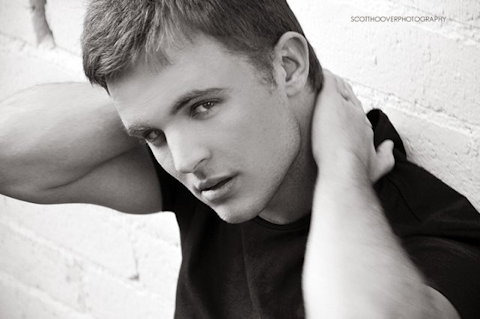
1992 – James Duke Mason is an American politician, writer, and political activist. He is the son of singer Belinda Carlisle and film producer Morgan Mason, and the grandson of the late British actor James Mason. In 2010, The Advocate listed Mason as one of the most influential young LGBT Americans in their "Forty Under 40" issue. He was named in OUT magazine's 2011 "Out 100" issue as one of the 100 most influential LGBT people in the world.
Born in Los Angeles, Mason moved to Europe with his parents as a child. In an Attitude Magazine interview, Mason stated that he is openly gay and that he came out to his family and friends at the age of 14 in 2006. After graduating from Mougins School, an international school in the south of France in July 2010, Mason moved back to the U.S. to study Political Science at California Lutheran University. After a year he moved to West Hollywood, California to focus on his efforts in grassroots advocacy.
He was appointed to serve as a Page in the U.S. House of Representatives during the summer of 2008, and also worked as a volunteer for Hillary Clinton during the 2008 Democratic primaries. He has appeared on TV shows such as Dr. Phil, Nancy Grace, and Politicking with Larry King to discuss LGBT issues, has written articles for websites such as The Huffington Post and The Advocate, and did a YouTube video to back the It Gets Better campaign.
In December 2011 it was announced that Mason was appointed to the board of directors of Outfest, making him the youngest member in the organization's 30-year history. He began his term in January 2012.
He served as an official surrogate for the campaign of Barack Obama in the 2012 U.S. Presidential Election. He had a small acting role in the film What Happens Next, which screened as part of the Hollywood Film Festival. He was a candidate for the West Hollywood City Council in the March 3, 2015 election.


1998 – Ghislaine Landry is a Canadian rugby union player. She won a gold medal at the 2015 Pan American Games as a member of the Canadian women's rugby sevens team. During the 2016-17 season, Landry succeeded Jen Kish as captain of the national sevens. On 20 October 2018, Landry became the first woman to hit the 1,000 point milestone in the women's sevens World Series.
In 2016, Landry was named to Canada's first ever women's rugby sevens Olympic team, which won the bronze medal in a match against Great Britain. In 2017, Landry moved into first place all-time in HSBC World Rugby Women's Sevens Series scoring with 706 points. In June 2021, Landry was named to Canada's 2020 Summer Olympics team.
Landry attended Saint Francis Xavier University.
She came out as homosexual in 2006 and married her partner in 2018.
In 2021, she announced her retirement from the sport, hanging up the boots at the age of 33 after an illustrious international career that spanned a decade.


2009 – Iowa becomes the third state to allow same-sex marriage.


8 notes
·
View notes
Note
what old hollywood movie would you recommend me watching (i haven’t really seen any before so whats your favorite ig?? or which do you really like. idk feel free to infodump if you want though)
I'm so excited to answer this okay💞💞💞
So first off my number one recommendation is The Adventures of Robin Hood (1938) which is my favorite movie and it is wonderful. If you like The Princess Bride you'll like this too. It's so good please watch it!!
I'm going to list a couple more but I'm gonna categorize them :D (but also as an aside some of these movies definitely have moments that are absolutely not okay but that you kind of have to filter out)
Comedies:
It Happened One Night (1934) this movie defined the romcom and it is absolutely wonderful!!
Top Hat (1935) not totally a comedy but like. Fred and Ginger
Hands Across The Table (1935) I can't make a comedy category without including Carole Lombard! This movie is so sweet
It's Love I'm After (1937) this movie deserves so much more praise it's great
Bringing Up Baby (1938) HILARIOUS
Four's A Crowd (1938) critically panned difficult to understand and a personal favorite of mine
Holiday (1938) this movie makes me sad but it's also funny so idk. Hepburn and Grant what more do you need
The Philadelphia Story (1940) LOVE!!!!!!!!!!!!!
The Lady Eve (1941) I don't remember it very well but I remember really enjoying it, especially the first hour!
Arsenic and Old Lace (1944) I just watched this and I adored it!
Singin' in the Rain (1952) again it's a dance movie but it's so funny
Gentlemen Prefer Blondes (1953) this movie is so much fun!!!
Some Like It Hot (1959) if you watch one movie from this category let it be this one. You have GOT to watch it
Film Noir:*
Double Indemnity (1944) I cannot say enough good things about this movie
Laura (1944) spectacular wonderful you will be on the edge of your seat
Leave Her to Heaven (1945) very unique for a noir but I really enjoyed it!
The Postman Always Rings Twice (1946) John Garfield and Lana Turner and it's like good and stuff
Gilda (1946) I don't remember the plot at all but Rita Hayworth is so attractive in this movie so if the plot is bad it does not matter
Sorry, Wrong Number (1948) WONDERFUL performance from Barbara Stanwyck. Verrrrry tense
Sunset Boulevard (1950) again if you watch one movie from this category it should be this one it's one of the best movies I have ever seen
*honorable mentions to Kirk Douglas for good performances that I really like in The Strange Love of Martha Ivers (1946) and Out of the Past (1947) which are both good movies but they're not my favorites
Drama/movies that make me really sad:
Stella Dallas (1937) watched it with a friend, got home, and cried
Four Daughters (1938) singlehandedly launched my John Garfield obsession and ruined my entire day
Wuthering Heights (1939) apparently it's not accurate to the book but I adore this movie and cry every time
Goodbye, Mr. Chips (1939) it's kind of boring but I couldn't function for like a day
Waterloo Bridge (1940) when I rewatched it I started crying in the first five minutes so
The Little Foxes (1941) tour de force from every single actor
Now, Voyager (1942) rewired my brain
Gaslight (1944) watch Ingrid Bergman act circles around everyone else ever for two hours
The Best Years of Our Lives (1946) three hours of exploring PTSD but it is worth all of the tears I promise
The Heiress (1949) three powerhouse actors and a great script and an amazing director!! This movie is AMAZING
White Heat (1949) watch James Cagney act circles around everyone else in the movie for two hours
All About Eve (1950) very similar to Sunset Boulevard but also different. I love this movie
A Streetcar Named Desire (1951) changed my entire life
Twelve Angry Men (1957) SPECTACULAR
Hitchcock:
Rebecca (1940) wonderful showstopping great I love this movie
Shadow of a Doubt (1943) godddd the family dynamics of this movie!!! The suspense!! The acting!!!
Strangers on a Train (1951) sooo spooky but sooo good
Rear Window (1954) a classic it's very suspenseful you'll love it
Vertigo (1958) my best friend my favorite my dearest dear. Truly one of the best movies I have ever seen in my entire life
North By Northwest (1959) Cary Grant in yet another situation and it is so fucking good
#this is WAY more than you asked for#but this is like. THE list#i probably forgot some things though#thank you for asking :DDDDD#i appreciate it so so much!!!!!!!!!!!!#old hollywood#asks
29 notes
·
View notes
Text
people just think all femme fatales are like babara stanwyck in double indemnity and while she is a highly influential type femme fatales can and do have various degrees of agency in their stories they are not always the masterminds or schemers. one of the most iconic rita hayworth as gilda has very little agency in fact she's almost completely at the mercy of her husband and her ex-lover. there are also just straight up victims like gloria grahame in the big heat. some are caught up in the larger story at play like many of lauren bacall's characters or gene tierny in laura. at times the trope is quite misogynistic as it can come off as villainizing a woman's victimhood and framing her as evil for taking back control of her life. but almost always even when she has agency, she is still defined by a dominant male figure in her life whether its husband, father or boyfriend, which is why a lot of femme fatales are the girlfriends of master criminals/gangsters.
7 notes
·
View notes
Text
I Can Do This All Day
Pairing: Steve Rogers x Female!Reader
Word Count: ~800
Warnings: fluff
Request by anon: What if in "cat and mouse" au, Vixen dose a mission with the avengers before that they sneak peak on her skills by using bucky and steve both bulk super soildiers against a stealth type . She ends up getting them to fall on the mat or clashing on eachothers faces and vixen finds it fun not guilty from training unlike hydra someone plays a beat music at the next round as a mock fight starts to match the music so dose vixens strikes , dodges and few fight moves bucky cant help but be at awe with it and steve didnt figh his grin with the fight style reader has . Also bet when vixen and yelena meet Instant bffs for the chaos and relatable things they do
Request by anon: Cat and mouse crack
Bucky*poses as a muse* little drafty here
Vixen and cap*sketch /paint"
Steve:its ok buck the heat is on too
Vixen*smirks while sketching/painting*what if he did one of thoes Turn of the century nude poses
Steve*blush*i-it could work
Bucky*grins*What a good idea *drops the drapped fabric tied from his hips
Vixen*blush* ever used that on steve
*steve blushes furiously*y/n!!>~<
Bucky:yes , yes i did
Request by anon: Cat and mouse au, Vixen singing alone in a free time to the song "put the blame on mame" by rita hayworth for fun . She thinks shes alone till steve hears it . You can take the 1930's out of the girl but she loves her vintage from time to time
Summary: Tony still doesn’t trust you to be on your own, and the only place he’ll let you go is the training room. When you do, you face off with the legendary Captain America and Winter Soldier. Time to show off your moves.
Squares Filled: slow burn (2021) for @avengersbingo
Part One: Cat and Mouse
Part Two: Femme Fatale
Author’s Note: any and all comments are appreciated <3

Tony hasn’t let you out of your cell since they’ve tested your blood, but he did give you more art supplies to make your time go by faster. You’re pretty sure that this was Steve or Bucky’s doing, but you got a radio to help pass the time.
You love listening to music from the 30s and 40s since that’s all you’ve ever known. You hate modern music and how twisted they are right now, so having that comfort music is relaxing. The song you’re in love with at the moment is “Put The Blame On Mame” by Rita Hayworth. She has a sultry voice that calms you down, and it’s perfect for sketching.
You grab the black oil pastel crayon and begin shading the picture while singing softly with the song that’s playing. All the walls are glass, but you didn’t see anyone else inside the main room. You grab another oil pastel crayon when you hear your crush’s voice.
“Didn’t know you could sing,” Steve says. “You have a nice voice.”
You look up to see Bucky and Steve enter the room and stop by your cell.
“Thanks, Steve. What are you doing here?”
“What, we can’t visit you for fun?”
“Want to entertain me? Tony isn’t allowing anyone to come in here. He thinks I’m going to go berserk and kill people to escape,” you roll your eyes.
“How are we going to entertain you?”
“Want to be my muse?” you grin and hold up your art supplies.
“I think Bucky would be a good model,” Steve volunteers his friend.
“What do you want me to do?” Bucky sighs.
You look around the barren room and see curtains on some of the windows. You get an idea when you see Bucky wrapped around the curtain.
“Get naked and wrap that curtain around your waist. I’d really love to capture the part where the metal meets your skin.”
“Alright,” Bucky groans.
He walks over to the curtain and yanks it off the rod before joining his friend. He stips down so that he is completely naked, but he wrapped the curtain around himself before you saw anything.
You move to the glass wall and take a seat so that Steve can see without showing Bucky. He doesn't do an extravagant pose, but he does give you something to work with. You start with his chest since that is the most interesting area.
After five minutes, Bucky breaks the silence.
“It’s a little drafty in here.”
“The heat is on,” Steve says.
You take three minutes of sketching when you get an idea for Bucky to do. The thought makes you giggle, and Steve smiles from hearing it.
“What?”
“What if he did one of those turn-of-the-century node poses?”
“I-I mean if he wants to,” Steve stutters.
“What a good idea.”
Bucky drops the curtain so that he is completely nude in front of you and his friend. Your eyes immediately go down to his cock, and even soft, he’s big. It makes you think what Steve looks like, but you force that out of your head.
“Impressive,” you nod.
“Wait until you see Steve,” Bucky smirks.
“Okay, Buck, that’s enough.”
The door opens and Tony walks in. He takes one look at Bucky and cries out in shock, and Bucky scrambles to cover himself with the curtain.
“Okay, not sure what is happening here, but do you want to get out of this cell?”
“Yes. What are we doing?” you ask eagerly.
“You’re training with these two idiots. Suit up.”
He leaves the room to let Bucky get redressed, and once everyone is ready to go, Tony comes back. He enters your room with his suit on just in case you decide to flip your shit and attack him. You don’t, but that doesn’t stop him from handcuffing your wrists together.
“Do you really think I’m going to escape?”
“Can’t ever be too sure.”
He takes you to the main training room where Bucky and Steve follow behind lightly.
“Don’t kill each other, but I want to see what you’re capable of. Go nuts,” Tony says while taking off your handcuffs.
He leaves the training room, and he puts on some rock song he usually listens to whenever he is working in his lab. As soon as the song starts, you jump into action. Both super soldiers charge at you with the intention of hurting you, but you’re not going to let that happen.
Bucky tries to take you from behind while Steve goes to your front, and the dark-haired super soldier gets the better of you. Bucky grabs you and holds you against him, and you kick your feet up so you’re essentially walking up Steve’s chest. You walk up and kick him in the chest and use that momentum to flip over Bucky and pin him to the ground.
You jump away and walk over to the two men who are on the ground trying to catch their breath.
“See that Tony? I got skill,” you grin.
“Not bad. Let’s go again.”
“Are you two up for another round?”
“I can do this all day,” Steve grins.

If you want to be tagged, add yourself to this document! If your tag doesn’t work, find out why!
@thejourneyneverendsx @mrspeacem1nusone @miraclesoflove @moonstar86 @mogaruke @notyourtypicalrose @alex12948 @kendall-michele @niall2017 @kiwihoee @casseythebee @welcometothefandommultiverse @deliciousangelfestival @babypink224221 @1marvelnerd3000 @prettysbliss @fanf1ctionwrit1n @unstablecaffeinatedmind
#steve rogers#steve rogers fic#steve rogers fanfiction#steve rogers fanfic#steve rogers fiction#steve rogers fan fiction#steve rogers fan fic#steve rogers fluff#captain america#marvel#marvel fan fiction#marvel fanfic#marvel fic#marvel fanfiction#marvel fan fic#marvel fiction#marvel fluff#mcu#mcu fic#mcu fiction#mcu fanfiction#mcu fan fiction#mcu fanfic#mcu fan fic#mcu fluff
27 notes
·
View notes
Photo

The Strawberry Blonde (1941)
During the height of the Old Hollywood Studio System – when studios themselves contracted directors, actors, writers, and other craftspersons – Warner Bros. found its niche as the “dark” studio. Warners might not have invented the gangster picture, but they codified its archetypes and tropes, becoming synonymous with the subgenre. In the early 1940s, director Raoul Walsh (a film noir pioneer; 1940’s They Drive by Night and 1941’s High Sierra) was nearing the peak of his career and actor James Cagney (1938’s Angels with Dirty Faces, 1949’s White Heat) was perhaps Warners’ most bankable star. Walsh was known for his proto-noir works and crime dramas; Cagney arguably the era’s definitive gangster actor. By 1941, both needed something different to work with.
Adapted by brothers Julius J. and Philip G. Epstein from James Hagan’s pastoral stage play One Sunday Afternoon, The Strawberry Blonde was exactly what both men sought. The Strawberry Blonde – often billed as a romantic comedy because it is a much lighter adaptation than 1933’s One Sunday Afternoon (starring Gary Cooper and Fay Wray) – is a celebration of simple, unadorned love. Though not a gag-a-minute comedy, Walsh’s uncharacteristic film shines through the performances from Cagney and especially Olivia de Havilland (three years removed from The Adventures of Robin Hood and two from Gone with the Wind). It is a joyous and nostalgic production; perhaps it should be no wonder it was a career favorite film for Walsh and a highlight for Cagney.
The Strawberry Blonde occupies two time periods. The film is set in New York City sometime in the late nineteen aughts or early 1910s, but primarily told through flashback during the late 1890s. In the flashback, Biff Grimes (James Cagney) aspires to become a dentist and yearns for a strawberry blonde socialite named Virginia Brush (Rita Hayworth; whose singing voice is, in a fleeting scene, not dubbed for the only time in her career). Along with his buddy and soon-to-be business partner, Hugo Barnstead (Jack Carson), they go on a messy double date with Virginia and her friend, the nurse and suffragist-leaning Amy Lind (Olivia de Havilland). Upon first impressions, Biff considers Amy to be the less attractive, amusing, and sociable girl. When fate – or, more precisely, Hugo’s duplicity – intervenes, Biff and Amy find love together and marry. While Biff begins studying for a dentistry diploma by mail correspondence, the two navigate financial and personal travails. Despite the marriage, Biff harbors a stewing resentment towards Hugo and a lingering covetousness towards Virginia apparent in the film’s bookends.
Among the bit players are Alan Hale as Biff’s father; George Tobias as Biff’s and Amy’s Greek immigrant friend, Nicholas Pappalas; Una O’Connor as Mrs. Mulcahey; and George Reeves (a future television Superman) as a belligerent, loudmouth, mustachioed college man who – due to his sweater – I choose to believe is from Yale. The four actors listed here, all Warner Bros. contractees at the time, each have their memorable moments.
The Strawberry Blonde serves as a memorialization to the time of Walsh and Cagney’s upbringing, similar to Vincente Minnelli’s Meet Me in St. Louis (1944) at Metro-Goldwyn-Mayer (MGM) and, if one wants to draw a modern throughline, the Duffer Brothers’ Stranger Things. In many ways, the film also feels like a musical. There are numerous diegetic performances of songs – whether by our central cast or a band – popular during the turn of the century. “The Band Played On” (from which the film derives its title; “Casey would waltz with a strawberry blonde / and the band played on”), “Bill Bailey”, “The Fountain in the Park”, “Meet Me in St. Louis”, “Wait ‘Till the Sun Shines, Nellie”, and much more fill the soundtrack. Composer Heinz Roemheld’s (1942’s Yankee Doodle Dandy, 1947’s The Lady from Shanghai) work adapts many of these songs into a boisterous, energetic score. Roemheld knows when to dial his orchestra back during the film’s most intimate scenes, but this wall-to-wall score evokes the period. Ostensibly, according to the screenplay, it was a time of romantic walks and live music performances in almost all social settings. In a sense, these decisions make The Strawberry Blonde into a sort of half-musical.
With his most recent movie being the film noir High Sierra (1941) with Ida Lupino and Humphrey Bogart, the transition from a largely outdoors-set crime drama to interior-heavy romantic comedy nevertheless suited Walsh. Walsh receives immeasurable help from one of the best cinematographers ever in James Wong Howe (1941’s Abe Lincoln in Illinois, 1963’s Hud). Howe’s signature high-contrast, low key lighting – generally associated with film noir – is not present much in The Strawberry Blonde. But what Walsh and Howe accomplish is making a bygone decade contemporary again. Outside the film’s romantic scenes including Cagney and de Havilland or Cagney and Hayworth, the film’s frames overflow with activity. With masterful use of blocking and mise en scène in these moments, Walsh and Howe’s frames are always dynamic, moving – but not swooping – alongside masses of extras and supporting characters rather than staying put, as if taking still photography. A static camera during Biff’s dates out on town would immediately render The Strawberry Blonde as a dusty artifact, a creaky throwback. Stationary cinematography has its uses when there are plenty of actors on-screen, but such a decision would make this remake too much like its 1930s original. Instead, in conjunction with Orry-Kelly’s (1951’s An American in Paris, 1959’s Some Like It Hot) outstanding costume design, the past leaps out of the history books and memories to be present again.
youtube
The notable instances in which Walsh and Howe keep their camera as rigid as possible are when Biff finds himself at the park bench where he and Amy first met. The set for the park also happens to be art director Robert M. Haas’ (1941’s The Maltese Falcon, 1949’s The Inspector General) plainest craftsmanship in the entire film. These scenes are the most obviously soundstage-bound moments – the too-perfect grass, the flatness, and lack of discernible lighting – despite the extras strolling in the deep background. The Strawberry Blonde’s park scenes mark the beginning and the renewal of Biff and Amy’s relationship, rendering them arguably the romantic highlights of the film. The contrast from these scenes to places such as the beer garden, the Central Park Zoo, or the Statue of Liberty make them the least “present” of the film. Some viewers less experienced in Old Hollywood (or those who, wrongfully, dismiss the style altogether) might complain about the obvious artifice in those park bench scenes with Biff and Amy, but my goodness does the aesthetic contrast make one take notice. Not only that, but the Epstein brothers’ dialogue for Cagney and de Havilland here is gently funny, and filled with warmth.
James Cagney, with his vaudeville background, was known for his physically exaggerated performances that nevertheless maintained a raw emotional core. That works to his benefit throughout The Strawberry Blonde, in which the character of Biff often sounds calm and measured, but his words bely fearfulness and bitterness. Despite the tough-guy gangster persona he often played in Warners’ gangster pictures, there are shades of Cagney’s later performance as George M. Cohan in Yankee Doodle Dandy here. Look at the grace in his dancing at the beer garden, a seemingly spontaneous cartwheel upon learning wonderful news, and how he putters about restlessly when conversing with Amy for the first time while expecting Virginia to show up. But also notice his weariness during the film’s bookends, how he accepts – but does not despair about – his station in life.
Olivia de Havilland is Cagney’s equal in this film, and a great foil to Rita Hayworth (whose character of Virginia is depicted as more conventionally attractive, but possesses a casual cruelty and vanity that gradually reveals itself). A middle-class nurse is an unusual role for an actress known at the time for mostly playing rich women and/or Errol Flynn’s love interest in swashbucklers or Westerns. As Amy, de Havilland curiously receives two “introductory” scenes in the film – both radically different from the other in storytelling function, reflecting the rarity of a second first impression and Biff’s tendency to see only surface details. Seemingly reserved but playful when she wishes to be, de Havilland’s Amy is an absolute delight of a character from the moment she appears. One crucial moment late in the film – in which Biff is dancing around an implied truth so that he can soften the blow for Amy – is heartbreaking acting from both. De Havilland’s movement and her glance outside the window in that scene epitomizes the agony in that moment. Knowing both actors’ resumes, I initially came into The Strawberry Blonde thinking that, on paper, Cagney and de Havilland would be a romantic mismatch. What a happy surprise it is to be completely wrong.
Unlike contemporary films that might take a nostalgic trip to a decade like the 1970s, ‘80s, or ‘90s, The Strawberry Blonde feels, at times, truly transporting. The incredible attention to visual details and especially the diegetic music (too often those newer nostalgia-driven movies resort to pin drops of non-diegetic music) help immensely. Though the film suggests an immigrant experience that would have been appropriate for turn-of-the-century New York, The Strawberry Blonde declines to say more about it – most likely a result of the original source material (“pickaninny”, a derogatory term that refers to black or dark-skinned children, is casually used in a song’s lyric).
At the center of this rich period detail lies an honest love between two people flowing through life’s currents. Sometimes their love is troubled with melodramatics, but they find ways to comfort and help the other with humor and goodness. Sure, it can be sentimental stuff. But it endures an upsettingly difficult test. The Strawberry Blonde has no designs to being other than a sincere love story and a fond lookback of another time. As such, it triumphs – with just one more chorus of “The Band Played On”, if you please.
My rating: 7.5/10
^ Based on my personal imdb rating. My interpretation of that ratings system can be found in the “Ratings system” page on my blog (as of July 1, 2020, tumblr is not permitting certain posts with links to appear on tag pages, so I cannot provide the URL). Half-points are always rounded down.
For more of my reviews tagged “My Movie Odyssey”, check out the tag of the same name on my blog.
#The Strawberry Blonde#Raoul Walsh#James Cagney#Olivia de Havilland#Rita Hayworth#Jack Carson#George Tobias#Una O'Connor#George Reeves#Lucile Fairbanks#Julius J. Epstein#Philip G. Epstein#James Wong Howe#Heinz Roemheld#Hal B. Wallis#Orry Kelly#WB100#TCM#My Movie Odyssey
8 notes
·
View notes
Text

Let's get glamorous 💃🏼! Our girl Rita Hayworth knew how to bring the heat 🔥 with her iconic style and beautiful smile. She paved the way for countless Hollywood superstars 👑. #legendsneverdie
6 notes
·
View notes
Text

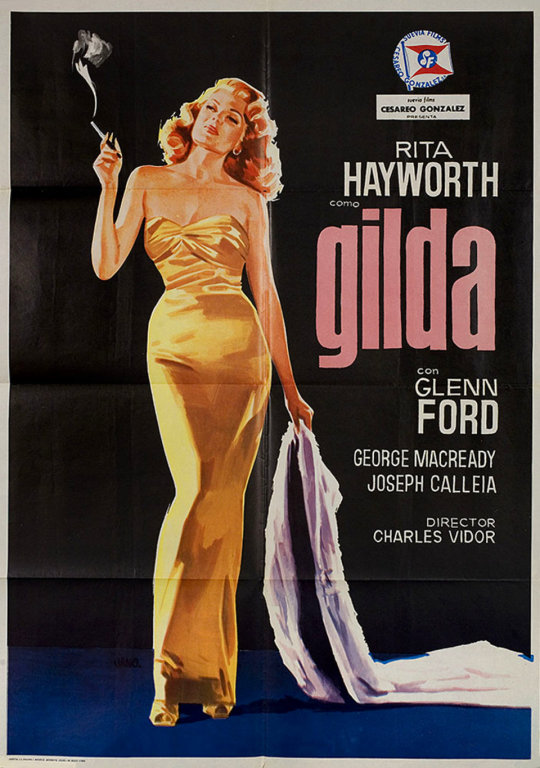
-+
Put the Blame on Mame
"Put the Blame on Mame" is a song by Allan Roberts and Doris Fisher, originally written for the classic film noir Gilda (1946) in which it was sung by the titular character, played by Rita Hayworth[2] with the singing voice of Anita Kert Ellis dubbed in.needed]
In keeping with the film character Gilda being "the ultimate femme fatale", the song sung by her in two scenes facetiously credits the amorous activities of a woman named "Mame" as the true cause of three well-known cataclysmic events in American history: The Great Chicago Fire of 1871, the Great Blizzard of 1888 in New York City and the 1906 San Francisco earthquake. Mame is also credited with causing the fictional shooting of Dan McGrew during the Yukon Gold Rush, an event derived from a short narrative poem published in 1907 by Robert W. Service.
The song was later reprised as an instrumental version in another quintessential noir film, 1953's The Big Heat, when Gilda star Glenn Ford first meets Lee Marvin's character in a bar. It is again played in 1954's Human Desire, also starring Glenn Ford.
Put the Blame on Mame (littéralement « Rejetez la faute sur Mame »), est une chanson humoristique écrite par Allan Roberts (en) et Doris Fisher (chanteuse) (en) pour le film américain Gilda sorti en 19461. Ce titre y est chanté par le personnage-titre du film joué par Rita Hayworth. La chanson intervient à deux reprises dans l'histoire, l'une interprétée par Rita Hayworth elle-même, l'autre où la voix de l'héroïne est doublée par Anita Ellis (en).
La version interprétée par Anita Ellis est classée à la 84e place dans la liste des « 100 plus grandes chansons du cinéma américain » de l'American Film Institute2.
La chanson évoque une femme fatale, Mame, à laquelle reviendrait la faute de tous les maux du monde3, le grand incendie de Chicago en 1871, le grand blizzard de 1888 qui a dévasté New York aussi bien que le tremblement de terre de San Francisco en 1906, et même la mythique fusillade de Dan Mac Grew (en) qui aurait eu lieu en 1905 durant la ruée vers l'or du Klondike. Le refrain dénonce à chaque fois les explications qui ont été données de la catastrophe en précisant que la véritable responsable, ce serait « Mame » :
0 notes
Text
The Week Ahead 7/23-7/29
Go ahead, make your week exceptional. With our help, you can do it while saving a bit of dough. There's plenty of fabulous parties, shows, and drinks to savor so you can swig your way to the perfect summer in this magical place we call home...
$29: 2 Hour Open Bar Tiki Party, Including Special Tiki Cocktails!
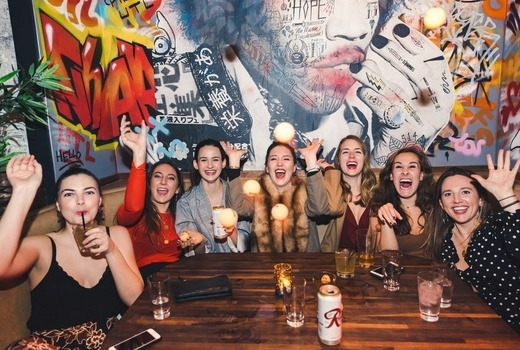
If island life is what you crave, you'll find it in Flatiron at SPiN, a haven of indulgence, joyful feels, and fun that is serving up a tropical feel like no other, all without hopping on a plane! Their Open Bar Tiki soirée is set to pour up an epic time, so drink, dance, and even dine in delight! While you drink endless pours of Tiki cocktails, show off your skills on the ping pong table or via a game of life-size Jenga, taking a break to hit the dance floor...
Video Tour: Capturing Cinematic Shots

Discover simple camera techniques to create stunning videos on iPhone. Experiment with depth and focus in Cinematic mode and learn how to add composition, angles, and movement to your recordings. Then you'll head out to different locations and collaborate to capture your best shots!
$29 Wellness Fridays: Booze, Beauty Treatments, Yoga, & More

Looking for an escape from the summer heat? Rejuvenate at Grayson Hotel’s Midtown Meltdown series, a limited-time lobby experience curated to provide you with a satisfying summer sanctuary. You'll get access to a 2 Hour Open Beer & Non-Alcoholic Wellness Drinks Bar, Free Samples from participating brands, the opportunity to try Beauty Treatments or a Calming Yoga Stretch Sessions, plus more surprises in store! There's more where that came from! Heyday Skincare will provide 10-minute microcurrent treatments, while Heatwise Yoga will guide you through a calming stretch session. Shop the Frank & Oak pop-up so you can can grab a complimentary tote bag to hold all of your new goodies, and sip on delish libations to cool you off even more...
All-Star Jazz Party
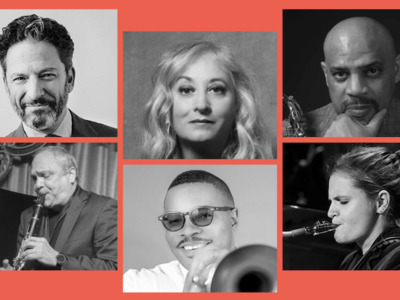
Bill Charlap, John Pizzarelli, Renee Rosnes, Steve Wilson, Ken Peplowski, Jeremy Pelt, Nicole Glover, David Wong, and Dennis Mackrel will be playing for you! Each artist a star – each, one of the definitive performers on their instrument – together, a constellation. Join 92NY for the brilliance, chemistry, and a night of music that will only happen once and only happen there.
$19 VIP 2 Hour Open Bar Tix: Open Bar Disco Fever Fridays Party

Experience the revival of Studio 54 at Copacabana's exclusive and alluring Disco Fever Fridays Party! Prepare to groove and dress in your finest disco-era attire, as Copacabana, known for its innovative experiences, transforms its space into a dreamy discotheque. Since the 1940s, this spot has been frequented by celebrities like Diana, Princess of Wales, Marilyn Monroe, Rita Hayworth, Brigitte Bardot, Madonna, Elton John, and Marvin Gaye! So, let loose and get ready for an extraordinary night of drinks, dancing, divas, and dazzling company at Copacabana's Disco Fever Fridays - a true throwback to the golden era of Studio 54!
Champe-Soukous Collective Performance

The Champe-Soukous Collective is an All-Star ensemble that bridges the Trans-Atlantic connection between Colombian champeta and it’s source music of Central African/Congolese soukous-rumba. With members from Central Africa and Colombia, the force of this un-paralleled Champe-Soukous Collective will be an Afro-Colombian dance party not to be missed!
1 note
·
View note
Text
Nine Hundred
Like swallowing a bowling ball
This coffee taste like dirty old pennies
From hell
While the veins
In my
Legs/arms/ears/nose
Blister outward and
Cause me to
Hunt down and join
A pilgrimage
To beach blanket bimbos
Homes inside trailer parks
On the water’s edge
And the bass cannot stop
The tune
Though wounded and bleeding
It is not dead
Yet
Nor am I
Because I can still
Hear myself laughing at you
With your
Las Vegas eyes
All digital blue
And beyond
Any phony bologna
And you
Want to scream
And let it out
All the passion that
You hold back
Inside your pale
Vampire skin
You wanna carry that weight?
You wanna talk about anxiety?
I’m all fucking ears baby
Look at me now
Listening to you
And your
100 year old curse
That you lift and carry around
In that sack that
Some folks call skin
I don’t call it anything
But that’s just me
So now
With the boil on your chin
You finger it deeply and
It’s all puss sweetie
It’s all pits
It’s all over now
While my skin
Balloons out from the
Constant heat of 100 stars
So fuck me
Hard
Keep the boots on
For cry it out loud
Fuck me hot
So the band of gold
Will melt right off
My fat disgusting finger
And into a pool of
Broken honeymoons
And migraine bedrooms
I’ll tear apart your bra
And rip to shred those
Tight panties that you wear
Day after day
You’ll regret everything now
(Believe it)
And there is nothing you
Can do
To prevent another night
Of sonic orgasm and
Nails down your
Straight as an arrow back
With the marks all over it
From the pony
You fucked last night
And I know you
You rolling stone…
You’ll split the scene
Bleeding positively
Upon the carpet
To the pavement
To the seat of your
Car
Where you will adjust your
Wig in the
Cracked
Rearview mirror ball
Crank up the
Fuzzy guitar of garage bands USA
And drive onward
To a destination that
Only you could possibly know
And it occurs to me,
I wonder about you
And how you plan on making it
Without a
Paycheck in your pants pocket
Or anything valuable
Between those legs of yours
You will fail
Now say it with me…
I will fail
Do you feel better now?
That you got that off that
Rita Hayworth chest of yours?
And before I return back home
I’ll dye my hair a
Rusty shade of red
And insert a
Nylon guitar string
Into my nose and up my nasal cavity
And with laser like precession
It will end up coming out
Of my left eye socket
And damn,
You were not here to see
Such miracles occur
So with little time left
I place the razor
Hard against my forearm
And
Slip and slide it
Back and forth until
The shade of bone glows through the cranny berry blood
And I will wait for the oven to
Preheat to 400 degrees
And the car in the garage is going past four hours of
Plain old idling
And soon
The heavens will be
All mine
And I will sit with God
In his temple
And downward we will look
And spy on you as
You throw those
Tattered jeans into
The stream for a
Quick cleaning
And with no soap
To call your own
you realize you
miss my smell
my fragrance
my odor
that is so 100% natural that
you could bottle it up
and sell it to every granola
nut who walks on by
and God gives me a
high five and pats me on the ass
as I walk out of his mansion and
into my quarters where all the music in the world
will play all at once
and no
it is not confusing
not in the least
its beautiful like you
used to be
when the mornings
were ripe with promise
and the clouds were all
out of sight wonderful
and the heavens rained golden tears of chamomile on us all
and we would take off our shirts
and dance like
turkeys do
every last Friday in
November
And I miss you already
As I grow more and more
Tired
So I take to the kitchen and place my head
Down onto the oven door
And my ear
Sizzles and cooks a little
Bit and I can only crack
A
Smile
And wait
For it all to come to me
I thought you wanted to save me
And in the last minute
It appears I am doomed by my own shaking
Hand
And I am
As the motors are all dead
And the police bikes have all
Flat tires from the shattered glass from your
Poorly manufactured windshield
And you shake off the shards
While my capsule has emptied out
And I am floating along the skyway
Alone and with only the barking of dogs
Off in the distance as my only
Sensation
And will you cry any tears of
Oil for my much too early passing?
Will you weep for me darling?
This dropout with a burned out
Memory and flakes of dandruff
In his soon to be completely
Gray head
My balls no longer hurt and my ears
Have lost that sensation of
Being clogged up
And I am nine words away from ending this
1 note
·
View note
Photo
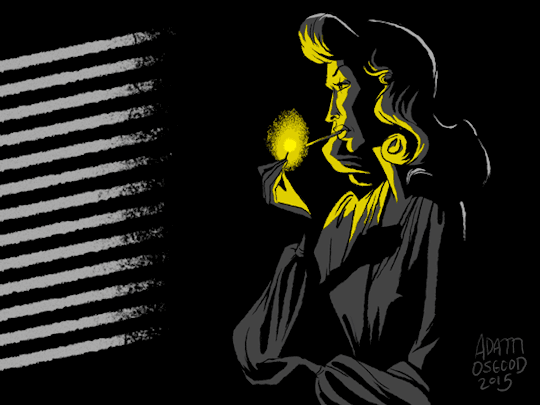

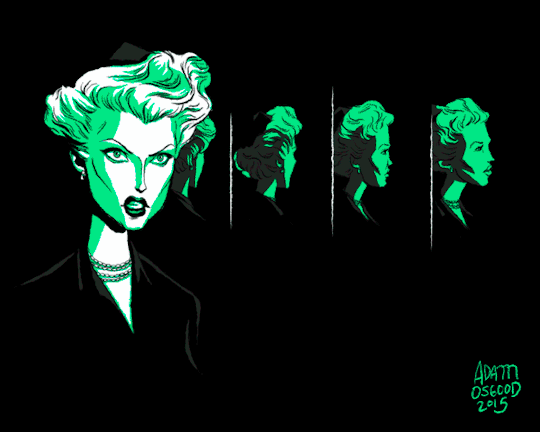

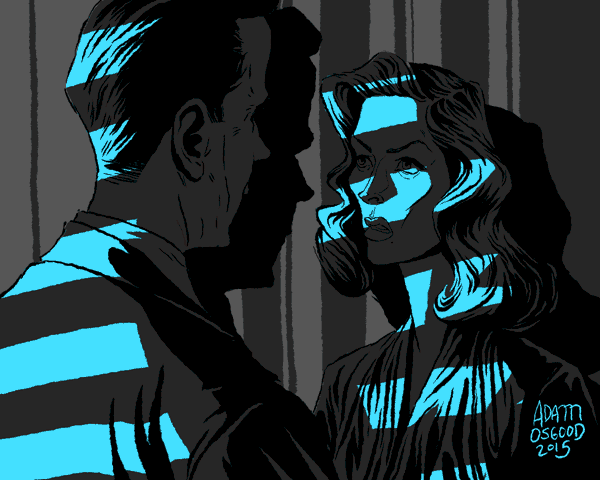

Femme Fatales by Adam Osgood
#barbara stanwyck#double indemnity#joan crawford#mildred pierce#rita hayworth#lady from shanghai#gloria grahame#big heat#lauren bacall#the big sleep#lana turner#the postman always rings twice#adam osgood#film noir#noirvember#gif
18 notes
·
View notes
Text
A Dance With a Dame
A/N: It feels like it’s been forever since I’ve written anything Bucky. So I dedicated some time for just that.
Summary: Bucky used to dance back then, he knew that for a fact. Only now with you, he couldn’t remember the charm he used. It was your weekly movie night and he hoped that perhaps things could change.
Word Count: 1,382
Pairing: Bucky Barnes x Reader
Warnings: Implied smut(I honestly don’t think so, but just to be sure)
Song: The Way You Look Tonight - Bing Crosby
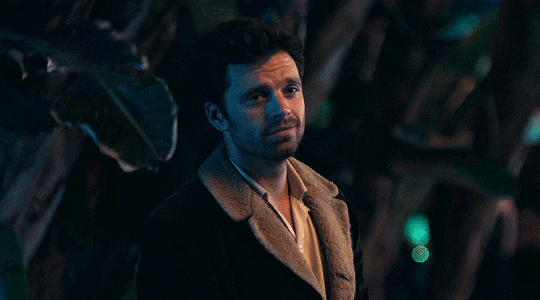
Dancing in the forties was a regular occurrence. Men asked the woman out on a date and he would proceed to take her dancing. It was just something that was done back then, because sometimes it was rare for there to be a picture house near enough to visit. Bucky for so long could not recall those moments he asked dames to dance. His mind thankfully had healed enough for him to remember the charming words he said that swept them off their feet. Only now those words sounded awkward coming from his mouth.
He wondered if perhaps things were so different now that you didn’t need to ask a dame to dance. It would give him some peace to ask someone that question, only he didn’t know if he had the ability to charm anyone. Especially you. After everything that happened with Wakanda and the war against Thanos, you and him became close. You fought side by side with each other; saved each other’s lives at the end of the day.
He wondered if it was the way you cared for him in a way no one else did, or if it was the way you could make him smile even in his darkest days. But Bucky Barnes had fallen in love. Hard. The last time he felt this way was back in the forties with a girl named Dot. He figured he’d marry her after the war, have children, and grow old enough to tell stories of his life. Only he’d ended up forgetting everything that could turn into stories.
You sat on your couch; your legs draped over his lap. It was the weekly movie night that you set up with him months ago, and tonight you’d picked a film from his era. Bucky was so invested in the black and white film that he didn’t notice how you looked at him. You’d rather admire everything about him than watch a film. Rita Hayworth and Fred Astaire danced across the screen and Bucky’s lips tiled up into a small smile.
He glanced your way and noticed you staring. Every other time you would have turned away. Pretended you weren’t looking at him as intensely as you were. Only this time you didn’t face the other way. You held his gaze and something in the air shifted. You could feel it. The song continued in the background, the film now forgotten about as you looked at each other.
Bucky shifted your legs and stood from the couch, his gaze burning into yours. If you were dreaming, you hoped that you would never wake up. He took your hands and pulled you up with him and towards him. A moment so intensely intimate, that it sent heat across your cheeks and nearly made you break your gaze.
Without words he wrapped an arm around your waist, clasping your hand into his. The song continued as Rita and Fred professed their love for each other. Oh, how fitting a song for that moment. Bucky led the steps, almost as naturally as he was walking. You wondered if the ground shifted or if it was just your heart.
A month ago, you realized. Sitting at the kitchen table with him in his small apartment in Brooklyn as he ate the slightly burnt pancakes he made, it hit you. He had a twinkle in his blue eyes that you’d never noticed before and suddenly you were falling. Bucky was your friend. How could you fall in love with your friend? Yet there you were, still sitting at that table, wishing you could tell him. You never did. The lingering fear of ruining things kept you from saying anything.
He was swaying you slowly, his steps every few beats. Your head leaned against his chest, listening to his heartbeat and he had his head against yours. How one movie night turned into you being wrapped in his arms you would never know. Neither of you were complaining though.
Taking a chance Bucky spun you slowly seeing a flash of your smile. For so long, Bucky felt as though he were drowning. Stuck in an everlasting expanse of water losing his breath as the pressure crushed his lungs the further he sank. He’d been drowning for decades. Only now, at that moment, his head broke the surface of that dark water, and he took his first gasp of air after so long.
You spun back into him and before Bucky knew what he was doing his lips were on yours. To say it rattled you would be an understatement. His lips against yours knocked you off your feet. The Earth must have definitely shifted, because you felt as if you were floating. He crushed you against him and moved his mouth against yours. A kiss meant to be sweet turned into longing, yearning, something he couldn’t use words to describe.
He wanted you in every way he could possibly have you. Teeth clashed against teeth and now it was you who was gasping for air. His tongue against yours, and his teeth nipping at your lower lip; all of it had you reeling.
“Bucky,” you gasped.
He pulled away, nearly ripping himself from you. “I’m sorry. I shouldn’t have…” He froze at the sight of your eyes looking at him like he’d never seen before, and your swollen lips he’d sucked at like it was candy.
“Why are you sorry?” you asked in a soft voice.
“I thought… I should have asked…” He couldn’t find the words again and it frustrated him to no end.
“Did you think I didn’t want to kiss you?”
He nervously ran his hand against the back of his neck, feeling the blush against his cheeks. “Yes.”
The kiss no longer felt like a shock to you, but this did. He didn’t think you wanted him in the same way he wanted you. Stepping closer you brought his hand to your lips and kissed it lightly.
“Bucky of course I wanted to kiss you,” you whispered. Looking up at him you nearly laughed at the pure disbelief in his eyes.
“You did?”
You smiled. “Of course. I love you.”
The words didn’t register, because he never thought he’d hear them. From anyone. You loved him. YOU loved him. No matter how many times he replayed it they didn’t hit him fully. How was it possible for you to love someone so broken, so destroyed, that he didn’t even remember what love was like? Yet you stood there looking thoroughly kissed and happy saying those three words he’d never thought he’d hear again.
“I hope you’ll kiss me like that again,” you said. That kiss seared you to the bone and you craved more. So much more than just the feel of his lips against yours.
Bucky yanked himself out of his mind and rushed towards you. He was sure that he’d never get tired of many things in his life. The taste of chocolate, the feeling he got watching movies with you. Only now all of that was gone. This was the one thing he’d never get enough of. The taste of you, the feel of you against him. You’d ruined him for all eternity.
“You have no idea how much I love you Y/N,” he said against your lips.
A laugh slipped from your lips. “Well I’m glad, because after that I’m never letting you go.”
“I’m glad too, because I’m yours. Always have been doll.” That small smirk came back to him every time he called you doll.
Over the years you’d never thought something could affect you so much. Again, you were proven wrong. Bucky and his broad smile, his smirk, his everything. All of it drove you to madness yet kept you sane at the same time. He ruined you just as much as you ruined him. You were his just as much as he was yours.
The movie ended, the credits rolled, and you still danced with him. It felt different being with him now that you’d said those words. Three little words that change everything. Perhaps it was the dance. Or maybe it surely was those small words. But Bucky Barnes knew for sure he’d fallen in love with you and now he could say you felt the same way.
Masterlist
#Bucky Barnes#bucky barnes imagine#bucky barnes x reader#bucky barnes one shot#bucky barnes fanfiction#bucky barnes drabble#bucky barnes x y/n#bucky barnes x you#bucky barnes dancing
179 notes
·
View notes
Text


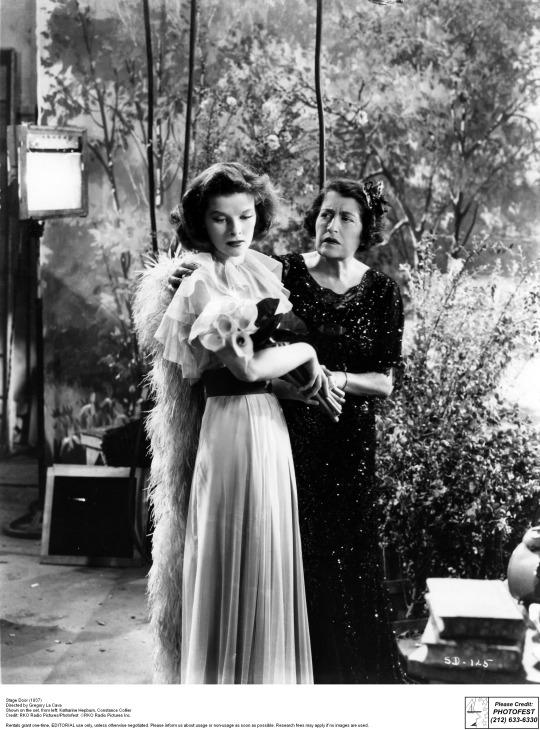


Rejoice, film noir fans! Noir Alley is back on TCM this Saturday night (May 15) at midnight ET with Orson Welles B-movie masterpiece, Touch of Evil (1958). There will be an encore presentation of Touch of Evil at 10 am ET Sunday.
Here's the rest of this week's TCM picks.
1. Waterloo Bridge (1940) at 8 pm ET/5 pm PT Monday, May 10: The star of the month tribute to movie Roberts continues with MGM star Robert Taylor in this WWI romance about the love affair between a soldier and a ballerina. This is a beautiful film on every level and it's our favorite performance from Vivien Leigh.
2. Stage Door (1937) at 7:30 am ET/4:30 am PT Wednesday, May 12: This fan favorite about a group of aspiring actresses who live in a NYC boarding house is airing as part of a birthday tribute to Katharine Hepburn.
The daylong Kate-fest includes a 1993 documentary All About Me at 9:15 am ET, classic screwball Bringing Up Baby (1938) at 6:15 pm ET, and Spencer Tracy and Kate's courtroom antics in Adam's Rib (1949) at 8 pm ET.
3. The Taking of Pelham One Two Three (1974) at 8 pm PT/5 pm PT Friday, May 14: This gritty '70s thriller about a hostage crisis in the NYC subway is a near-perfect popcorn movie with dynamite performances from Walter Matthau as a sweary transit police officer and the great Robert Shaw as an enigmatic assassin.
4. The Big Heat (1953) at 8 pm ET/5 pm PT Saturday, May 15: Touch of Evil is just the icing on the cake for a great Saturday night of noir that begins with a Glenn Ford double bill: this still shocking police procedural at 8 pm ET is followed by Ford and frequent costar Rita Hayworth in Gilda (1946) at 9:45 pm ET.
#TCM#TCM picks#TCM party#film noir#noir#noir alley#star of the month#Katharine Hepburn#classic movies#classic movie stars#old hollywood
25 notes
·
View notes
Photo
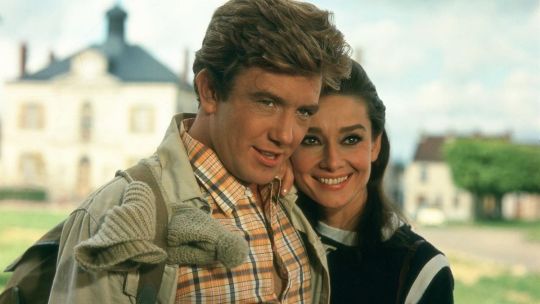
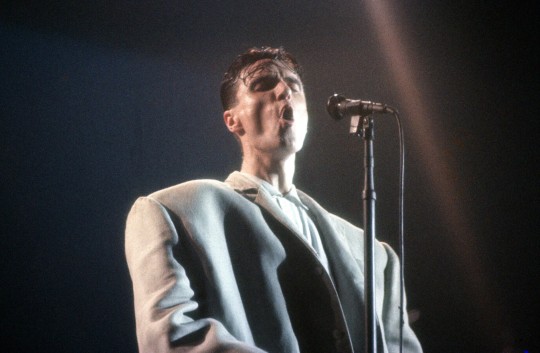
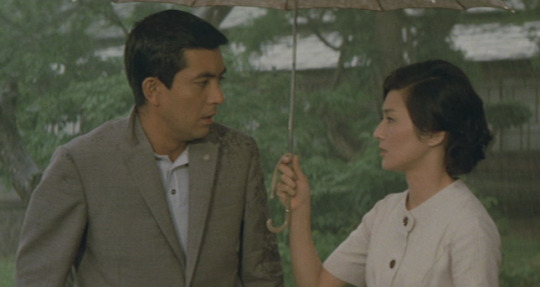
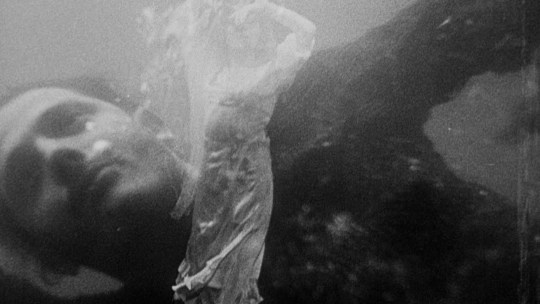

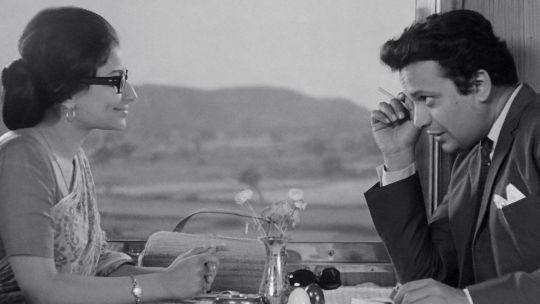

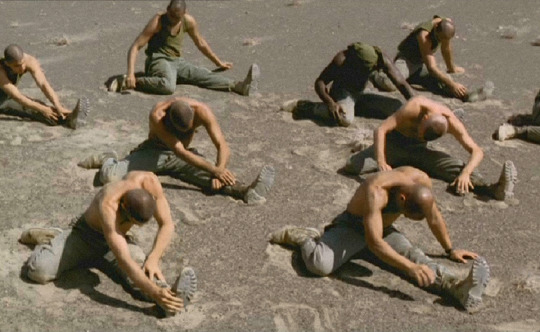
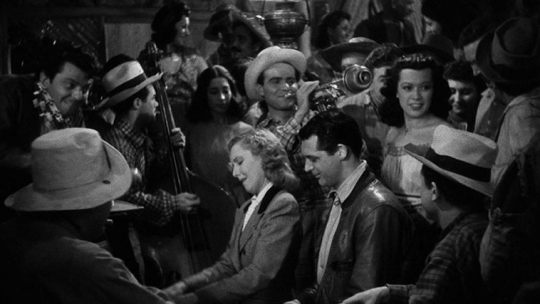

It’s the first day of 2021, which calls (yet again!) for my ten favorite new-to-me movies I watched in 2020!
The rules are the same as always: no movies from this past year (2020) or the year before (2019). Every other year is free game.
All ten of these movies are fascinating and beautiful and well worth your time, so consider this a strong endorsement for all of them. I’ve also included ways to watch all of the films (as of this writing, Jan. 1, 2021).
01. Two for the Road (dir. Stanley Donen, 1967; USA)
Donen takes the ideas of romantic cinema and celebrates it while injecting a healthy dose of painful reality. He chooses two of the English language's most attractive movie stars, Albert Finney (in full himbo mode!) and Audrey Hepburn, and follows their ten-year marriage as seen on their various road trips across Europe. It's a memory piece more than anything else, but the arc of their relationship is clear and their palpable connection burns through the screen. These are two beautiful, intelligent adults who love each other deeply, who are still physically attracted to each other, who are able to hurl verbal jabs and insults at each other with the best of them. Finney is magnificent, but Hepburn sort of steals the show. In what is probably her finest onscreen performance, she gets to grow from a virginal bride to a fully fleshed out adult, living beautifully in different shades of sexy and goofy and bitter. They make a screen couple for the ages. The script is funny without losing its honesty, it's tragic without leaning too far into artifice, it's romantic without being treacly. It's a remarkable balancing act and makes for a masterpiece. (Two for the Road is available to rent online or viewed at this link.)
02. Stop Making Sense (dir. Jonathan Demme, 1984; USA)
Stop Making Sense feels like a miracle. It hints at a narrative arc, but that part is unimportant. It’s a live performance recorded and packaged specifically for consumption as a film. In its brief runtime, it becomes a living, breathing, sweating testament to David Byrne’s skill as a performer, as a songwriter, as a storyteller, and to the remarkable talents of everyone in Talking Heads. It’s a breathtakingly joyous experience. I can’t remember the last time I watched a recording of a live performance that captured the same brand of energy, of buoyancy, that you feel as you’re leaving a great communal experience. This is a masterpiece that proclaims as loudly as possible that there is no joy greater than making art with people you love. (Stop Making Sense is currently streaming on Amazon Prime.)
03. Scattered Clouds (dir. Mikio Naruse, 1967; Japan)
Filled to the brim with unspoken turmoil and emotional devastation, Naruse's final film chronicles the rough terrain of a relationship between a widow and the man responsible for her husband's death. Spanning years and exploring just how deeply these wounds can go, much of the Scattered Cloud’s success rests on the performances from Yuzo Kayama and Yoko Tsukasa. Kayama is a handsome, likable screen presence who beautifully lives in his own cloud of grief. Tsukasa gets a bit more to chew on, as this really is her story: her arc and her inability to move forward, despite the best intentions, is one of the film's most lasting ideas. Brutally sad but incredibly beautiful. The work of a master filmmaker. (Scattered Clouds is currently streaming on the Criterion Channel.)
04. L’Atalante (dir. Jean Vigo, 1934; France)
My only regret with L’Atalante is that I didn’t see it sooner. The final (and only feature-length) film from Jean Vigo before his untimely death at 29, this film is a technical marvel and a humanist miracle. Featuring spirited performances from Dita Parlo, Jean Dasté, and the great character actor Michel Simon, and intoxicating dreamlike imagery, as well as a relentlessly romantic score from Maurice Jaubert, this film looks and feels like no other film from its era. (L’Atalante is currently streaming on the Criterion Channel.)
05. Daisies (dir. Věra Chytilová, 1966; Czechoslovakia)
Věra Chytilová's iconic masterpiece of anarchic cinema more than lives up to its reputation. Operating on its own chaotic wavelength, Daisies follows the exploits of Marie I (Jitka Cerhová) and Marie II (Ivana Karbanová) who seek to spoil themselves after realizing how spoiled the world is. They begin to live extravagantly and rip off older men and cause general mischief. Over less than 80 minutes, Daisies upends a whole slew of cultural norms. Beautiful, ambiguous, funny, cynical, and truly visionary. (Daisies is currently streaming on the Criterion Channel and HBO Max.)
06. The Hero (dir. Satyajit Ray, 1966; India)
The Hero sort of feels like Satyajit Ray's answer to 8½ in its meditation of fame and regret. Uttam Kumar is fantastic as Arindam Mukherjee, a superstar actor who works through his career and his loss of values in an interview with a reporter played by Sharmila Tagore, who is also fantastic. Under Ray's sleek direction, gracefully opening up the world of the train, and with his intelligent and human script, the cast uniformly sinks their teeth into this film. Kumar is the MVP out of necessity -- without him, the whole film would fall apart -- but the whole ensemble is remarkable, peppering the background of the train scenes and in Arindam's flashbacks. This also has one of the all-time great nightmare sequences. Easily one of the master director’s best films. (The Hero is currently streaming on the Criterion Channel.)
07. Malcolm X (dir. Spike Lee, 1992; USA)
Malcolm X is a truly massive film housing an even bigger performance from the great Denzel Washington. Tracing Malcolm X’s life and career while juggling numerous tones and visual styles and spanning across decades and continents, this is surely Spike Lee’s most ambitious film up to this point in his career. Washington is onscreen for virtually all of its long runtime, from the early exuberant days before his imprisonment all the way up to that fateful day in the Audubon Ballroom, and he is, of course, tremendous. All that classic Denzel charisma and magnetism is on full display, whether in his impassioned speeches or in his more intimate scenes. Lee’s direction is top notch, making this full story about a life with an incalculably profound impact feel richly and deeply intimate. This is one of the essential American epics. (Malcolm X is available to rent online.)
08. Beau Travail (dir. Claire Denis, 1999; France)
Beau Travail’s place in the modern canon of world cinema is assured, and Denis is rightfully seen as a master, but it really can’t be overstated just how much of a gem this film is. Pepper with sparse dialogue (though always packed with meaning), the film lives in one of two modes: muscular, suntanned men doing slow, precise choreographed exercises in the heat of the day and those same muscular men dancing and gyrating with attractive young women in some ethereal nightclub. Between these poles lies Denis’ almost cosmic meditation on masculine ego, homoerotic obsession, and regret. A fascinating, enigmatic, devastating beauty. (Beau Travail is currently streaming on the Criterion Channel.)
09. Only Angels Have Wings (dir. Howard Hawks, 1939; USA)
Only Angels Have Wings might be Howard Hawks' crowning directorial achievement. The aerial work, the rainy nights, the beautiful atmosphere of the bars, the palpable camaraderie of the characters, the tragic loss of life and yet the persistence to move forward. Cary Grant leads a terrific cast, including a quietly moving Richard Barthelmess and a rarely-more-likable Thomas Mitchell, and his chemistry with both Jean Arthur (the most charming) and Rita Hayworth is a joy to watch. This film seems to dabble in multiple genres at once, subverting the cliches of the Hollywood formula while still embracing the melodrama and the artifice within. In that way, the film feels very strange, but if the viewer lets themselves be carried along with Hawks' unique rhythm, the reward is one of the most fascinating and exciting films in Hollywood's fabled 1939 output. (Only Angels Have Wings is available to rent online or viewed at this link.)
10. Closely Watched Trains (dir. Jiří Menzel, 1966; Czechoslovakia)
Between the precise composition of the shots and the young narrator-protagonist, Closely Watched Trains feels like a spiritual predecessor to Wes Anderson's work. This comparison extends to the thematic content of the film as well, as the story of a young man coming-of-age against the backdrop of the Nazi regime is definitely cut from the same cloth as The Grand Budapest Hotel. Lucky for me, I love Anderson's work, and Grand Budapest is my favorite of his, so Menzel's stylistic flourishes immediately endeared me to the film.Menzel maintains a skillful tonal balancing act throughout Closely Watched Trains. Even under the wry, almost self-deprecating humor, the film never loses track of preciousness of life and the horrific tragedy of war. Beautiful cinematography, strong performances across the board, a memorable score, and a clever script make this a gem of the Czech New Wave and a moving, delightful, and accessible coming-of-age tale. (Closely Watched Trains is currently streaming on the Criterion Channel.)
Honorable mentions (in alphabetical order): Ace in the Hole (Billy Wilder, 1951), The Band’s Visit (Eran Kolirin, 2007), But I’m a Cheerleader (Jamie Babbit, 1999), Carnival of Souls (Herk Harvey, 1962), A Cottage on Dartmoor (Anthony Asquith, 1929), Crossing Delancey (Joan Micklin Silver, 1988), Divorce Italian Style (Pietro Germi, 1961); Eat Drink Man Woman (Ang Lee, 1994), Fireworks (Kenneth Anger, 1947), The Freshman (Fred C. Newmeyer & Sam Taylor, 1925), The Hitch-Hiker (Ida Lupino, 1953), Kuroneko (Kaneto Shindo, 1968), Le Bonheur (Agnès Varda, 1965), Le Notti Bianche (Luchino Visconti, 1957), Like Father, Like Son (Hirokazu Kore-eda, 2013), Local Hero (Bill Forsyth, 1983), Love & Basketball (Gina Prince-Bythewood, 2000), Mad Max 2: The Road Warrior (George Miller, 1981), Monsoon Wedding (Mira Nair, 2001), One Sings, the Other Doesn’t (Agnès Varda, 1977), Pennies from Heaven (Herbert Ross, 1981), Pickup on South Street (Samuel Fuller, 1953), Rushmore (Wes Anderson, 1998), Seven Samurai (Akira Kurosawa, 1954), Sleepless in Seattle (Nora Ephron, 1993), Symbiopsychotaxiplasm: Take One (William Greaves, 1968), Tea and Sympathy (Vincente Minnelli, 1956), They Shoot Horses, Don’t They? (Sydney Pollack, 1969), Tomboy (Céline Sciamma, 2011), Wendy & Lucy (Kelly Reichardt, 2008), Within Our Gates (Oscar Micheaux, 1920), Whisper of the Heart (Yoshifumi Kondo, 1995), and Who Framed Roger Rabbit (Robert Zemeckis, 1988).
And some miscellaneous viewing stats:
First movie watched in 2020: A Fantastic Woman (Sebastián Lelio, 2017)
Final movie watched in 2020: Holiday (George Cukor, 1938)
Worst movie watched: The Notebook (Nick Cassavetes, 2004)
Oldest movie watched: Ten films by the Lumière Brothers (Louis Lumière, 1895)
Longest movie watched: Seven Samurai (Akira Kurosawa, 1954; 207 minutes)
Month with most amount of movies watched: December (58 movies, including shorts)
Month with least amount of movies watched: February (11 movies) (pre-COVID, naturally)
First movie from 2020 seen: Birds of Prey (Cathy Yan, 2020)
Total movies watched: 455
#sometimes elliott watches movies#year in review#two for the road#stop making sense#scattered clouds#l'atalante#daisies#the hero#malcolm x#beau travail#only angels have wings#closely watched trains
100 notes
·
View notes
Text
Astaire and Rogers Rewatch Part 11: Kisses, Partnership, and Final Thoughts
Fred Astaire and Ginger Rogers made 10 films together. That’s more than Judy Garland and Andy Hardy. More than Katharine Hepburn and Spencer Tracy. Almost one-third of Astaire’s musical filmography also stars Rogers. That’s incredible by the standards of any decade.
I’ve had a lot of thoughts throughout this rewatch and I’ve distilled some of the larger ones into this wrap-up post. So here we go.

Kisses
It felt important to talk about the kisses and distinct lack of them in their own section. As I mentioned in my Carefree post, Astaire didn’t like big romantic scenes, especially those that involved kissing. He preferred to let the romance happen in the dancing.
But here’s the problem with that:
After he made his last RKO film with Ginger Rogers, Astaire went on to make many more musicals with other leading ladies and he kissed all of them.
Look at 1941’s “You’ll Never Get Rich” with Rita Hayworth. Or Holiday Inn with Virginia Dale and Marjorie Reynolds (though I can’t remember if he kisses Reynolds). Or Easter Parade with Ann Miller and Judy Garland.
Through the rest of his film career, Astaire almost always kissed his leading lady. So what was the hesitancy with Ginger Rogers?
I know it seems like I’m making this all Astaire’s “fault” but… well it kind of was. It’s not like Rogers was stomping around demanding to be kissed. But she certainly wasn’t the one going off with the script with her spouse and coming back to declare for any number of reasons why she and Astaire shouldn’t kiss in the film. On the other hand, he was definitely doing that.
If you’re in any way thinking this was a case of “oh he didn’t like Ginger so he didn’t want to kiss her” let me stop you right there. Because you’re wrong (see my Barkleys of Broadway post as well as the Final Thoughts section here). And maybe it was the opposite.
Now look, I think you could chalk this up to Astaire being shy (which he was) or his newness to the movie business (also true) or simply an unease with romance on the screen. But it feels worth mentioning, again, that he and Rogers had a previous romantic relationship. They’d dated in New York prior to her moving to Hollywood. They also absolutely made out during that time because Rogers wrote about in her autobiography. So kissing each other was familiar territory.
I’ll just cut to the chase. Astaire had only been married for a few months when he and Rogers started making their series of films. By all accounts, he was deeply in love with his wife, whom he had spent two years pursuing. He may have felt that repeatedly kissing his ex-girlfriend on screen while also performing some undeniably sensual dance numbers wasn’t a good idea for the health of his new marriage.
Perhaps there were even lingering feelings between him and Rogers, though it must be noted that she was also married from 1934-1940 (to Lew Ayres). And if you have feelings for someone who is not your spouse, you need to have boundaries. Or maybe it was some combo of this and/or other factors.
In all, the Astaire/Rogers films don’t necessarily suffer from the lack of kissing between the two leads. A strange element to this discussion is the kisses we do get prior to the first “romantic” clinch in Carefree. There’s a peck on the cheek in Gay Divorcee and a comical kiss on the lips by Rogers (and it’s mainly one-sided) in Top Hat. But why not make either of those, especially the first one, an actual kiss??
And if comical kisses were going to be inserted anywhere, they should land in Roberta or Follow the Fleet, the two films where Astaire and Rogers have the snarkiest relationships because their characters have a history together.
Moreover, there are glaring moments where a kiss should obviously be. Such as somewhere in Swing Time. For goodness sake, they joke about not kissing in “A Fine Romance” and then have a scene where it appears they’ve kissed off-screen. Give us the real thing! Which they did, eventually, in Carefree and it’s… pretty lackluster imo. Their kisses in The Story of Vernon and Irene Castle and The Barkleys of Broadway look and feel much more heartfelt.
So sure, the Astaire/Rogers films aren’t worse off for not having their leads kiss but they could have sometimes been improved. Shall We Dance’s plot hinges on a secret relationship between the two main characters and yet we never see them actually romantic together. That said, it’s a bit entertaining, if also kind of annoying, how often the plots in nearly every Astaire/Rogers film bend over backward to avoid showing us a kiss.

(my gif)
Partnership
It’s undisputed that Rogers is Astaire’s greatest partner, both in terms of dance and on-screen companion. They play off each other remarkably well, with an ease that hints at their personal relationship. Astaire had spent most of his life partnered with his sister, Adele, so he had learned how to make a lady look good during a dance and put the audience’s focus on her.
But Rogers doesn’t really need his help. She commands the screen so entirely at times that it takes pointed effort to look anywhere but her. Her ability to continue acting (and acting well) in the midst of dancing absolutely sets her apart from not only Astaire’s other dance partners but other musical stars of the day. A large part of what makes her dances with Astaire so enduring is that she sells the romance, rapture, and joy of those minutes with him.
Katharine Hepburn quipped that Rogers gave Astaire “sex” and he gave her “class.” I think a more apt observation may be that he elevated/improved her dancing and she elevated/improved his acting. That makes sense to me since she was more experienced as an actress and he as a dancer.
Doing this rewatch made me even more resolute that every critic who remarks on her lack of technical dancing skills is an idiot. Just look at “Isn’t it a Lovely Day.” She matches Astaire step for step and he’s not exactly going easy on her.
Then there are the romantic duets. Let’s talk about the sexiness of those dances because look. Astaire had been partnered almost exclusively with his sister up until then. He’d had maybe maybe a handful of other partners prior to pairing up with Rogers on screen.
There’s no question he was a talented performer and choreographer but I do find myself asking exactly when and how he learned to look at his partner so seductively. He certainly wasn’t doing that with his sister!

Plus there’s the nature of his dances with Rogers. There is a heat between them that is especially pronounced during the Hays Code era of Hollywood. Even Flying Down to Rio, where they barely dance together, has some steamy moments. “Night and Day” in Gay Divorcee and, to a slightly lesser extent, “Cheek to Cheek” in Top Hat are very obviously dancing metaphors for sex. And Astaire and Rogers get away with it while also not diluting the meaning of the dance one single bit.
Astaire crafted those dances himself specifically for himself and Rogers so he knew exactly what he was doing and communicating and so did she. For a guy who jumped through hoops to avoid kissing his dance partner on screen until their eighth film together, he sure put a lot of tension, sexuality, and deep romance into their dances.
For her part, Rogers again matched him. Although I often commented about how much he smiles and gazes at her while they are dancing, she regularly did the same towards him. They injected softness and genuine affection into those dances. They were both good actors but it wasn’t always acting.

(my gif)
Final Thoughts
Every time I watch one of their films, I discover something new. There’s so much I wish we knew but we never will, like what they’re whispering to each other those times we can see them talking during a dance. Or what rehearsals, which were apparently grueling but filled with laughter, really looked like (“I’ll Be Hard to Handle” in Roberta is the closest we’ll get). Or the many other ways Rogers fine-tuned their dances, adding elements here and there that made a marked difference.
They held each other in very high regard and were extremely fond of one another. Michael Feinstein tells a story about meeting Astaire for the first time. Feinstein was playing piano at a party and Rogers, whom he knew, asked if he’d “met Fred.” When Feinstein replied he hadn’t, she took him over to meet her friend and former costar who shyly but sweetly listened to Feinstein fanboy over him.
Astaire and Rogers remained good friends throughout their lives, with him sending her a very sweet note that she cherished about her performance in Kitty Foyle (for which she won an Oscar) and also gifting her with an ornate travel watch at one point (as mentioned in the “feather dress” section of my Top Hat post). She said he was one of the few men she knew who was an excellent dancer off-camera as well as on. Their affection for one another is evident in their films and it’s one of the many reasons I come back to their movies again and again.
Thanks for joining me for this rewatch! I’ve gotten notes from a few of you and that’s been so kind and also a huge surprise. I was almost certain no one would read these posts lol

#fred astaire#ginger rogers#classic hollywood#old hollywood#fred and ginger#astaire and rogers rewatch
57 notes
·
View notes